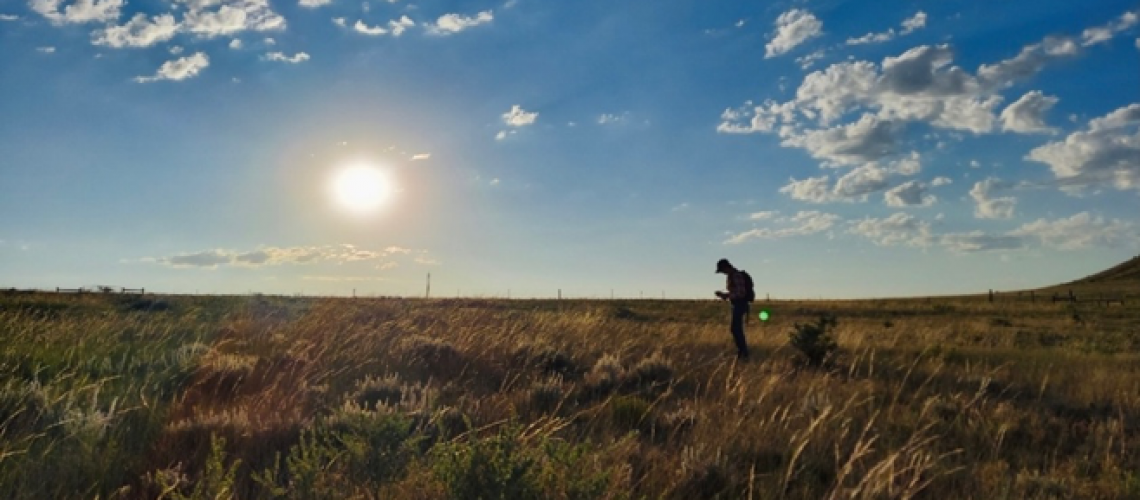Guest Post By Anna Clare Monlezun, 2021-2022 Sustainability Leadership Fellow and Ph.D. Student in the Department of Ecosystem Science and Sustainability at Colorado State University
Being Human
If being a human on Earth during a global pandemic wasn’t bad enough, how about being a researcher of humans? Or better yet, a student researcher whose completion of a lifelong dream depended on connecting with humans as a highly contagious virus gripped society as we knew it? Let’s conjure the metaphor of my son’s LEGO collection. Imagine thousands of pieces on a rug that is about to be shaken out by a strong flip of the wrist at one end. Well, that was me.
I am a PhD student at a Research-1, Land Grant university, Colorado State (CSU), studying collaborative grazing management on Colorado’s Northern Front Range. I work with government-owned conservation lands, coupled human-natural systems, that are managed to protect and conserve natural resources, provide public access to wild open spaces, and sustainably produce quality food for growing populations. Such systems are highly dynamic, complex, and interconnected, where feedback cycles traverse social and ecological dimensions (Liu, Dietz et al. 2007). There is a need for more interdisciplinary research engaging the multi-dimensionality of coupled human-natural systems, especially in rangeland ecosystems where humans, animals, and the environment share a long and turbulent history (Curtin, Sayre et al. 2002, Brunson and Huntsinger 2008, Briske, Sayre et al. 2011, Provenza, Pringle et al. 2013, Roche, Schohr et al. 2015).
In response to this need, my research team is working under a holistic research model honoring the three pillars of sustainability: ecological, economic, and social. We are partnered with three government agencies—the Colorado State Land Board, City of Fort Collins, and Boulder County—to study the ecological and socio-economic dynamics of landscapes that are managed in-part by cattle grazing leases held by local ranchers (Fig. 1). Our study offers a scientific program that integrates the human dimension in ecology and natural resource management and fosters stakeholder solidarity and interdisciplinary collaboration among multiple academic departments, local rancher producers, and government agencies. We intend that our model will constructively impact collaborative conservation efforts on local, regional, and potentially global levels.
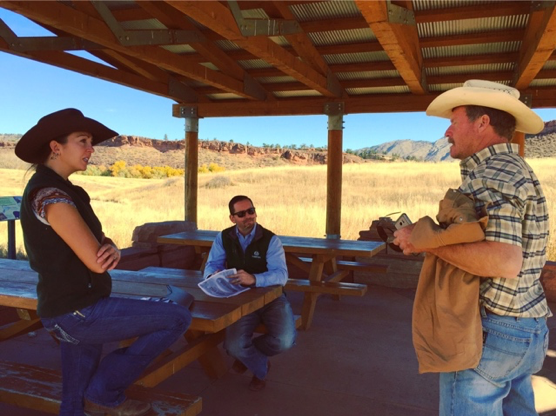
The Plan
The ecological portion of my study investigates differences and similarities between areas that have been historically managed with cattle grazing and areas that have been excluded from grazing. We collected field data for soil and plant community variables, as well as conducted ArcGIS geospatial analyses to generate a landscape-scale perspective. The field research involved just me, a field technician, and time isolated in remote landscapes or on a computer. I was quite confident that spending hours in the company of plants, various four-legged mammals, and insects was not going to put anyone at risk for contracting COVID-19 (Fig. 2). However, the socio-economic piece of my research, that unique layer, that perspective that would set my study apart from so many others, was going to be tricky.
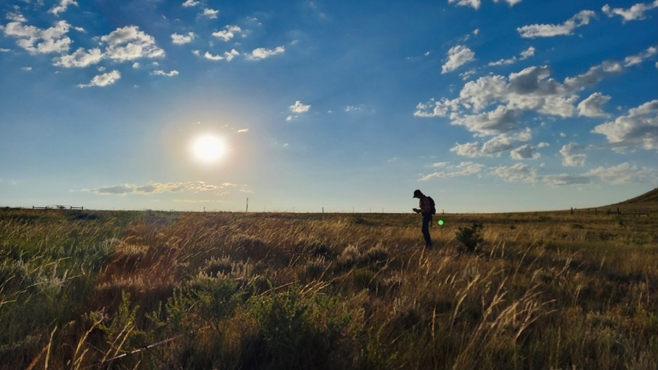
Figure 2. Anna Clare Monlezun conducting field work, Soapstone Prairie Natural Area.
I had planned to use a method called Q-Methodology to explore the human socio-economic component of my research. Q-Methodology provides a context-based, semiquantitative analysis for socio-cultural valuation of ecosystem services and conservation research, while capturing the diversity that exists in these complex and dynamic systems (Armatas, Venn et al. 2014, Lein 2018, Zabala, Sandbrook et al. 2018, Rost 2021). Ecosystem services is a concept popularized by the 2005 Millennium Ecosystem Assessment, which defined them simply as “benefits people obtain from ecosystems” (MEA 2005). Ecosystem services are embedded in the field of environmental economics and ecology, where both monetary and non-monetary values are used to inform the management and governance of natural resources (MEA 2005).
My objective was to gather critical information about rangeland ecosystem services from the people most closely tied to these multi-use government lands. My goal was to recruit 40 stakeholders, including government land agency workers (conservationists, biologists, field technicians), rancher producers, and community member recreationers to talk with me about their valuation of ecosystem services. Through the Q-Methodology process, we would look at how interdependent perceptions, values, and attitudes vary across different groups of stakeholders. There are six key steps in Q-methodology that needed to be carefully implemented to ensure a meaningful synthesis from diverse subjective viewpoints (Webler, Danielson et al. 2009) (Fig. 3). Whew! Do you see how much human-to-human contact would be required here?
The Opportunity
So how was I to adapt this research method to our new circumstances? How was I going to convince 40 people that my study was worth their time and attention amidst such an unpredictable and volatile moment on this planet and to participate in a multi-step process that may span up to 12 months? Q-Methodology has been around since the 1930’s, and while online software now exists, I wished to create a hybrid model based on the traditional method that would be more personal and adaptive. This was the catalyst: being a graduate student trying to move forward in life without delay, during the 21st century coronavirus pandemic. It was a beautiful mess. Only now can I look back and say that!
What this predicament gave me was not a roadblock. It was an opportunity to practice being professionally adaptive, creative, and innovative. It was an opportunity to practice tenacity, flexibility, and perseverance. So, what did I do? First, I held brainstorming sessions with several key people, my academic advisor, a committee member with experience in Q-Methodology, and a former PhD student who ran a Q study several years ago. I also tried on the shoes of my potential participants, all with varying degrees of pandemic responses and fluency with online or virtual platforms. What approach would convince me to participate in my study? I promptly assimilated the ideas and experiences of these mentors and landed on a game plan. I decided that being completely transparent upfront and connecting one-on-one over the phone and/or by email, while offering flexibility and adaptations to the classic methodology was the best way forward.
The Adaptation
I did just that. To recruit Q-Methodology participants, I used a method known as participatory sampling. I connected strategically with someone from each partnering government agency, who served as recruiting hub. I offered a brief description of my study and my direct email address and phone number to anyone considering participation. I spent hours visiting with potential participants. I made sure that my personal passion and genuine interest in the study came through in my communications. I explained how important this kind of research is for the lands that we love and call “home” here in Colorado. I assured people that results of the study would circle back to them, and how important it was that this study offered learning opportunities for everyone who participated. It worked! In just a little over a month, I had commitments from 40 people. I was ready to launch Step 1 of Q-Methodology.
The first step was to survey participants for values, opinions, and beliefs about the ecosystem services associated with relative study areas. This information would later be mined and pared down to become the Q Sample (Fig. 3). For this step, I offered participants several options. I emailed comprehensive questionnaires as PDFs and Word docs. I also offered snail-mail and included return postage to those who didn’t work so much over a computer. I offered an oral questionnaire via phone call, for those who preferred more personal contact. Within just a couple of months I had 100% participation in Step 1.
In Step 2, I used a qualitative data analysis to extract major themes and concepts from the surveys to create the Q Sample, a set of 36 statements that reflect concepts for which participants are most likely to have an opinion. The next step that required participation from stakeholders was the Q Sort exercise (Fig. 3), which was more complicated. Traditionally, this is done in-person, in a group or individual setting in 3-D, with scissors and glue, a Q Sort diagram (Fig. 4) and statements printed on pieces of paper (aka the Q sample) (Fig. 5), that would then be assorted onto the diagram. I realized that not everyone would be willing to break out the ole scissors and glue. I mean, we were living in an age of life and death. People were dying of this horrid disease, and I was asking survivors and loved ones to sit down for an hour or so with paper, scissors, and glue? I, therefore, figured out how to adapt the Q Sort exercise to an online platform, Google Jamboard (Fig. 6). This offered a private virtual Q Sort diagram option, although some participants still followed through with using the paper version. It was as easy as click and drag. It was now spring of 2021, vaccines were available, and pandemic response recommendations had become less rigid, so I also offered to meet with participants one-on-one in a COVID-19-safe setting, where I could verbally facilitate the Q Sort exercise. It was a hit! Again, using a combination of these adapted methods, I had 100% participation from participants in Step 3.

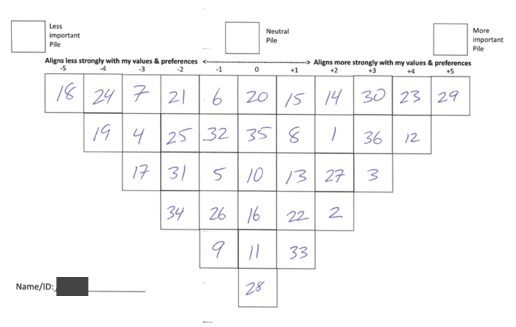
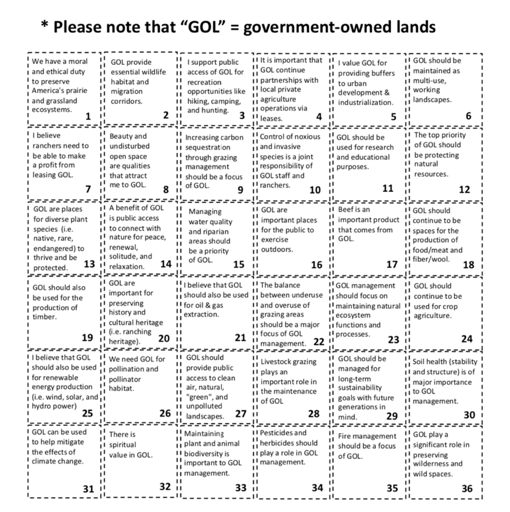
The final obligatory step for participants was to participate in a 30-45 minute exit interview (Fig. 3). The exit interview was essential to understanding nuances in the Q Sort process, which would inform my interpretation of results. Again, flexibility was key. I offered to conduct interviews by phone, video conference on multiple platforms, or in person in a COVID-19-safe setting. These interviews also gave me a chance to unofficially survey participants about their experiences in the study. Some participants reported that they found it challenging to stick with the process during such extraordinary times but were hopeful that the results would be meaningful and informative. Other participants raved about how the study made them think about the research topics in ways they hadn’t done so before. They felt cognitively inspired and compensated for their time and effort. To my surprise, a few participants also expressed how fun it was to step out of their “norm” and work with scissors and glue, while other participants thought the Google Jamboard had been a vital option for their busy schedules. 100% participation for Step 4…
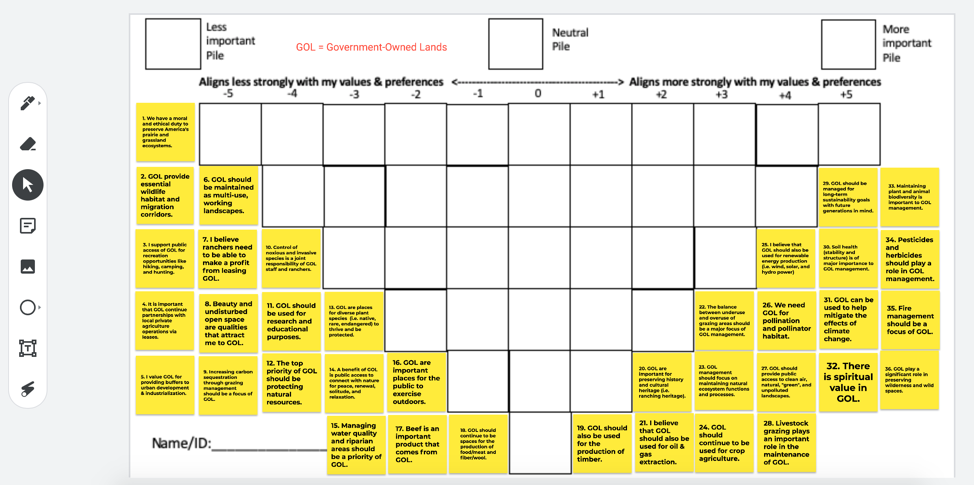
The Take Home Message
Today, I am in the process of completing Step 5 of Q-Methodology (Fig. 3), analyzing the Q Sort and exit interview data, while working through how best to learn from and communicate the results. I hope that sometime in 2022, I may be able to host in-person workshops with my brave and trusty participants to fulfill Step 6 (Fig. 3), so that I may effectively disseminate the results of their hard work and contributions, as well as facilitate group discussions for the purpose of social learning, consensus-building, and application – What does this mean for us? How can we apply our learning? What are our next steps?
For me, like many others, being a PhD student researcher in the heart of a global pandemic has been challenging on all levels: physically, psycho-emotionally, and socially. It felt like a damp cloud trying to suffocate any effort to feel or act as a “normal” human. For me also, I will look back and see how this experience was a brilliant catalyst. It taught me that there is always a way forward, even if it might not be the one for which I had planned. In the end, I not only completed the human dimension portion of my study with 100% participation from stakeholders, but I now have new innovative methods to share with the scientific community and other researchers who may be looking for just such adaptations. The way we communicate and interact with each other will likely never be the same as it was pre-COVID-19. We have learned to embrace (albeit reluctantly) virtual and distanced means of working together. It seems like an oxymoron, doesn’t it? But it doesn’t have to be.
As long as we also embrace our humanness and that of others, our capacity to work together for a common purpose comes through as a unifying golden thread. It requires a permissive alchemy of individuality, creativity, adaptability, and perhaps an unexpected catalyst. (That is the real moral of the story.)
Special thanks to the Western Sustainability, Agriculture, Research, and Education (SARE) division of the United States Department of Agriculture (USDA) and the Lowry Ranch Stewardship Advisory Committee for their support in this research project.
References
Armatas, C. A., T. J. Venn and A. E. Watson (2014). “Applying Q-methodology to select and define attributes for non-market valuation: A case study from Northwest Wyoming, United States.” Ecological Economics 107: 447-456.
Briske, D. D., N. F. Sayre, L. Huntsinger, M. Fernandez-Gimenez, B. Budd and J. D. Derner (2011). “Origin, Persistence, and Resolution of the Rotational Grazing Debate: Integrating Human Dimensions Into Rangeland Research.” Rangeland Ecology & Management 64(4): 325-334.
Brunson, M. W. and L. Huntsinger (2008). “Ranching as a conservation strategy: can old ranchers save the new west?” Rangeland Ecology & Management 61(2): 137-147.
Curtin, C. G., N. F. Sayre and B. D. Lane (2002). “Transformations of the Chihuahuan Borderlands: grazing, fragmentation, and biodiversity conservation in desert grasslands.” Environmental Science & Policy 5(1): 55-68.
Lein, A. M. R., George; Lopez-Hoffman, Laura (2018). “Q Methodology: A Method for Understanding Complex Viewpoints in Communities Served by Extension.” Journal of Extension 56(2).
Liu, J., T. Dietz, S. R. Carpenter, M. Alberti, C. Folke, E. Moran, A. N. Pell, P. Deadman, T. Kratz and J. Lubchenco (2007). “Complexity of coupled human and natural systems.” science 317(5844): 1513-1516.
MEA, M. E. A. (2005). Ecosystems and human well-being, Island press Washington, DC.
Provenza, F., H. Pringle, D. Revell, N. Bray, C. Hines, R. Teague, T. Steffens and M. Barnes (2013). “Complex creative systems: principles, processes, and practices of transformation.” Rangelands 35(5): 6-13.
Roche, L. M., T. K. Schohr, J. D. Derner, M. N. Lubell, B. B. Cutts, E. Kachergis, V. T. Eviner and K. W. Tate (2015). “Sustaining working rangelands: Insights from rancher decision making.” Rangeland ecology & management 68(5): 383-389.
Rost, F. (2021). “Q‐sort methodology: Bridging the divide between qualitative and quantitative. An introduction to an innovative method for psychotherapy research.” Counselling and Psychotherapy Research 21(1): 98-106.
Webler, T., S. Danielson and S. Tuler (2009). “Using Q method to reveal social perspectives in environmental research.” Greenfield MA: Social and Environmental Research Institute 54: 1-45.
Zabala, A., C. Sandbrook and N. Mukherjee (2018). “When and how to use Q methodology to understand perspectives in conservation research.” Conservation Biology 32(5): 1185-1194.
